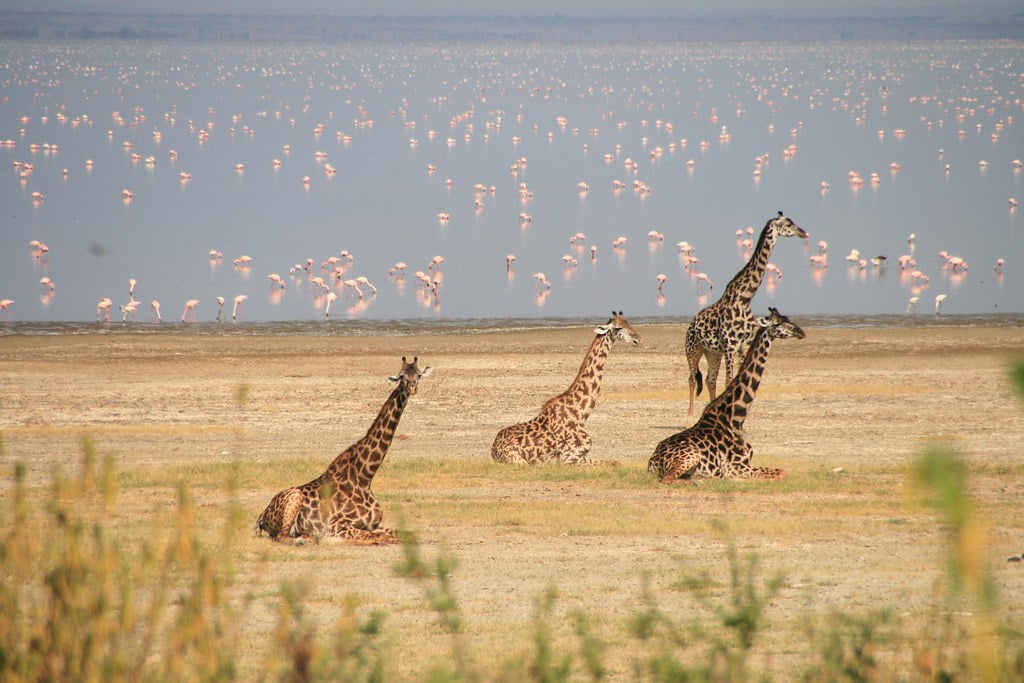Discover Giraffes in Tanzania, the majestic creatures that roam across vast savannas, towering gracefully above the African plains. Tanzania is home to a variety of wildlife, but the giraffe stands out as one of the most iconic and elegant animals you can encounter on safari.
When planning a safari with Future African Safari, encountering the towering giraffe is a quintessential highlight that embodies the grace and beauty of Africa’s wildlife. Renowned for their extraordinary height and distinctive spotted coats, giraffes are not only Tanzania’s iconic giants but also vital contributors to the ecosystem. In this blog post, we delve into the fascinating world of giraffes in Tanzania, exploring their unique characteristics, habitats, behaviors, and the conservation efforts that ensure their survival.


Majestic Giants of the Savanna
Giraffes (Giraffa camelopardalis) are the tallest land animals on Earth, effortlessly reaching heights of up to 5.5 meters (18 feet). Their long necks, adorned with unique coat patterns, allow them to browse foliage high above the ground, primarily from acacia trees. In Tanzania, giraffes grace the landscapes of renowned national parks such as Serengeti, Tarangire, and Ngorongoro, adding elegance to the sweeping savannah vistas.
Distinctive Appearance and Adaptations
Unique Coat Patterns: Each giraffe has a unique pattern of spots, much like human fingerprints. These patterns provide excellent camouflage among the trees and bushes, helping giraffes blend into their environment to avoid predators.
Long Necks and Legs: Giraffes’ elongated necks enable them to reach leaves that other herbivores cannot, while their long legs allow them to cover vast distances in search of food and water.
Specialized Tongues: Their prehensile tongues, which can extend up to 45 centimeters (18 inches), are adept at grasping leaves and stripping them from branches, even those covered in thorns.
Habitat and Distribution in Tanzania
Giraffes thrive in a variety of habitats across Tanzania’s diverse landscapes:
Serengeti National Park: Home to large herds, the Serengeti offers expansive grasslands dotted with acacia trees, providing ample feeding opportunities for giraffes.
Tarangire National Park: Known for its vast baobab trees, Tarangire’s open plains and woodlands are ideal for giraffes to roam freely and graze.
Ngorongoro Conservation Area: The mix of savannahs, woodlands, and volcanic landscapes in Ngorongoro supports healthy giraffe populations alongside other iconic wildlife.
Behavior and Social Structure
Giraffes are generally social animals, often found in loose herds that can range from a few individuals to over a dozen. These herds are fluid, with giraffes frequently joining and leaving groups. Key aspects of their behavior include:
Feeding Habits: Giraffes are selective browsers, primarily feeding on the leaves, buds, and fruits of trees and shrubs. Their feeding patterns help maintain the health and diversity of their habitats.
Communication: Giraffes communicate through a variety of vocalizations, body postures, and even infrasound, which is below the range of human hearing. These communications help maintain social bonds and coordinate movements within the herd.
Reproduction: Female giraffes typically give birth to a single calf after a gestation period of about 15 months. Calves are born already standing and can run within hours, a crucial adaptation for evading predators.
Conservation Status and Threats
Giraffes are currently classified as Vulnerable by the IUCN, facing several threats that impact their populations:
Habitat Loss: Expansion of agriculture, infrastructure development, and human settlements encroach upon giraffes’ natural habitats, reducing available grazing areas.
Poaching: Although not as heavily targeted as some other species, giraffes are still hunted for their meat, hides, and tails.
Human-Wildlife Conflict: Increasing interactions between giraffes and local communities can lead to conflicts, particularly when giraffes venture into agricultural lands in search of food.
Conservation Efforts in Tanzania
Tanzania is committed to the conservation of giraffes through various initiatives:
Protected Areas: National parks and reserves like Serengeti, Tarangire, and Ngorongoro provide safe habitats where giraffes can thrive without significant human interference.
Anti-Poaching Measures: Strengthening anti-poaching patrols and implementing strict regulations help protect giraffes from illegal hunting.
Community Engagement: Educating and involving local communities in conservation efforts fosters coexistence and reduces conflicts, ensuring that giraffes and humans can share the landscape harmoniously.
Research and Monitoring: Ongoing research projects monitor giraffe populations, health, and behaviors, providing valuable data to inform conservation strategies.
Tips for Spotting Giraffes on Safari
Maximize your chances of encountering giraffes with these tips:
Choose the Right Parks: Serengeti, Tarangire, and Ngorongoro are excellent locations for spotting large herds of giraffes.
Optimal Timing: Early morning and late afternoon game drives offer the best opportunities to see giraffes when they are most active.
Guided Tours: Experienced safari guides know the best spots and times for giraffe sightings, enhancing your chances of a memorable encounter.
Patience and Observation: Giraffes are graceful and often blend into their surroundings. Take your time, stay patient, and keep your eyes peeled for their distinctive silhouettes against the skyline.
Experience the Elegance of Giraffes with Future African Safari
Encountering giraffes on your Tanzanian safari is a testament to the beauty and resilience of Africa’s wildlife. At Future African Safari, we are dedicated to providing unforgettable safari experiences that showcase the grace and majesty of giraffes while supporting vital conservation efforts.
Ready to witness Tanzania’s elegant giraffes? Contact Future African Safari today to customize your Tanzanian safari and embark on an adventure that celebrates the stunning beauty and ecological importance of giraffes.
Explore more about our safari packages and discover the best of Tanzania with Future African Safari. Your unforgettable African adventure starts here!

